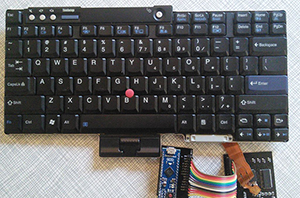 It doesn’t have buckling springs, Cherry blues, or even the wonderful if forgotten Alps switches, but the keyboard found in ThinkPads has the best keyboard action of any laptop around. They would make a great USB conversion keyboard, but the board to board connector is very hard to find, and no one has yet managed to get the keyboard and track point working as a USB HID device. Until [rampadc] came along, that is.
It doesn’t have buckling springs, Cherry blues, or even the wonderful if forgotten Alps switches, but the keyboard found in ThinkPads has the best keyboard action of any laptop around. They would make a great USB conversion keyboard, but the board to board connector is very hard to find, and no one has yet managed to get the keyboard and track point working as a USB HID device. Until [rampadc] came along, that is.
[Rampadc]’s keyboard adapter is built for the ThinkPad T60 keyboard, which is shared between the Lenovo T60, T61, Z60, Z61, R400, R500, T400, T500, and X41 laptops, among many others. The connector is an extremely odd proprietary deal, that can be found through the usual channels for about $5 in quantity 100. On top of this, the keyboard doesn’t have a controller – that’s offloaded to the laptop’s main board. The only electronics in this keyboard is just a matrix. Despite all this, [rampadc] managed to create a breakout board with a decade counter and an SPI GPIO expander.
The board [rampadc] made features one of the proprietary connectors, a few chips, and a receptacle for an Arduino Micro. With just a little bit of code, the old keyboard becomes one of the best portable keyboards in existence, and probably a bit cheaper than the official Lenovo USB-bound ThinkPad keyboard.
[rampadc] has a few of the expansion boards available over on Tindie should you want to build your own. It’s only cost-effective if you have one of these T60 keyboards sitting around in a junk pile; not a likely situation because these machines just don’t die.
















